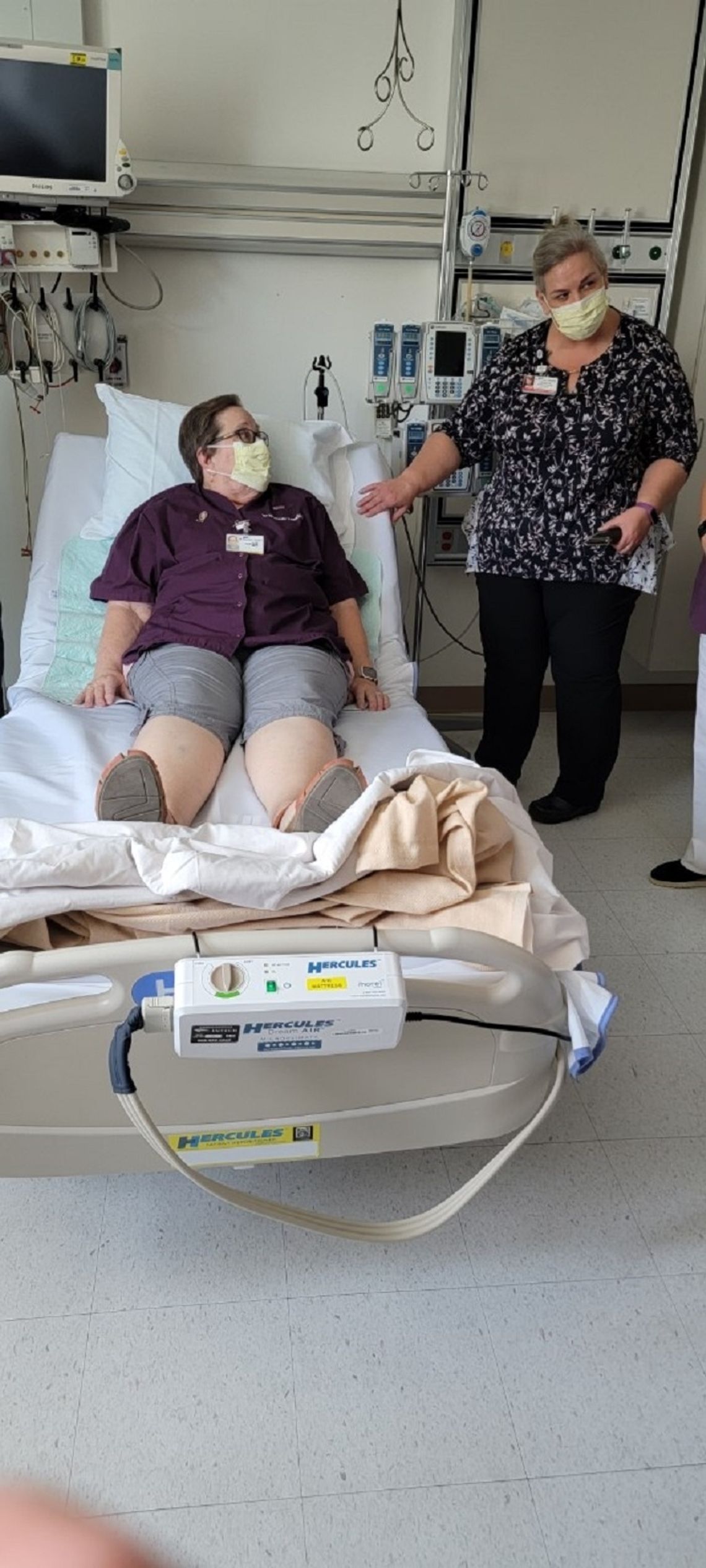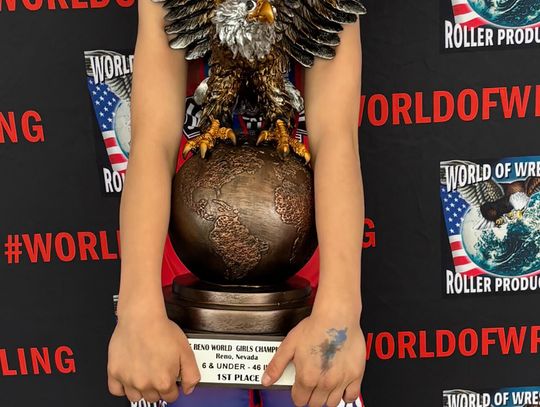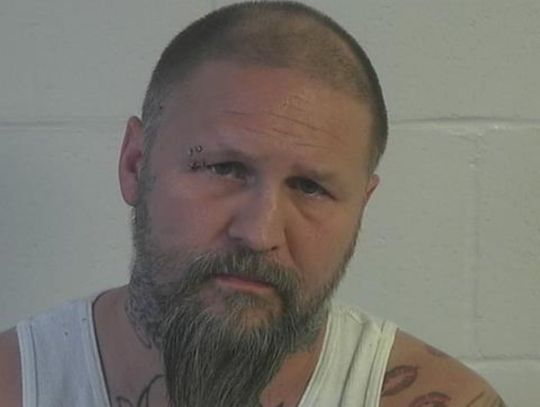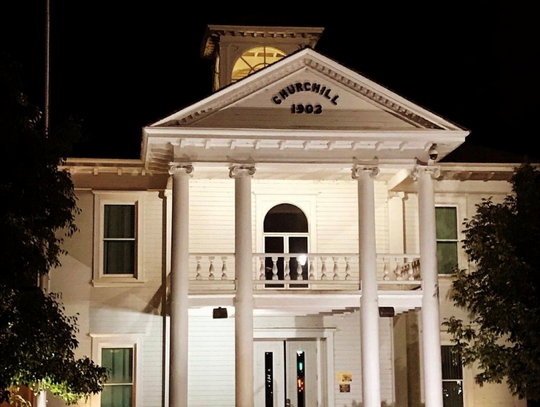The Banner Churchill Community Hospital Auxiliary organization, whose primary charter is to raise funds for hospital equipment and medical student scholarships, recently donated four Hercules Patient Repositioning beds and one Stryker Power-LOAD Lift System to the hospital. Auxiliary members were invited to demonstrations of the new equipment last Thursday.
Each of the four ICU rooms now has a Hercules bed that hugs the patient as it repositions them from laying down to a sitting up position. Banner Chief Nursing Officer Legay Naseath said, “Normally it can take anywhere from 2 to 6 nurses to reposition a patient, depending on how heavy the patient is. Now we don't have to scoot them up, it's more comfortable for them, and it also resolves pressure ulcers. So, by donating these to us, you have protected our patients and protected our staff from back injuries. This is such an incredible gift, and we can't thank you enough.”
Auxiliary Treasurer Pam Craig participated in the Hercules bed demonstration as Naseath described the bed. To Craig, she said, “So now we're going to raise you up so you can have your breakfast.” She pushed a button, and the sides of the mattress came in toward Craig holding her in place as the backrest part rose to a seated position. Craig never slid down as the backrest was being raised as typically happens to a patient in a regular hospital bed requiring the nurses to hoist the patient up while keeping them from tipping to one side or the other.
More than three years ago, Banner RN House Senior Manager Brittany Ortega attended a conference where she saw the beds, and Naseath said Ortega was the one to recommend them and they had been working on a way to get the funding for them since then. “When we couldn't get the capital dollars, Rob Carnahan, Banner CEO approached you guys (the Auxiliary). I can't tell you how much we appreciate this.”
Ortega said, “Part of our document to show how bad we needed these was to explain that nurses back here don't have CNAs to help when someone needs to be boosted up in bed. If they aren't positioned right, it can put pressure on places that can cause pressure injuries. When you're hoisting patients at least 5 to 10 times per shift, that averages boosting a patient about every 20 minutes, and the less mobile ones have to be moved even more often, sometimes every five minutes. These beds are a lifesaver. I actually admitted a patient yesterday while I was by myself, and it was so nice to be able to just push a button and boost him up. He was having breathing issues and it was faster for him to begin to breathe easier, and it was easier on me.”
The Stryker Power-LOAD Lift System has been installed in one of Banner's ambulances. According to the manufacturer's website, the Stryker Power-LOAD system consists of a powered cot fastener installed inside the ambulance that attaches to the hydraulic stretcher and supports it for the entire loading and unloading process. The two units work together to allow EMS personnel to raise, lower, load, and unload the cot at the touch of a button, thereby improving safety for both operator and patient.
EMS Steve Towne explained their work life before the power lift. “We would manually pick up the gurneys and slide them into the back. The stretchers weigh about 125 pounds, then add the weight of the patient and equipment, and it gets real heavy. The folks that have been doing this awhile, our backs have a shelf life, so having these lifts extends our careers, and reduces injuries significantly. Some studies show an 80-90% reduction in injuries by using these lifts. Going back 30 or 40 years, the average life span of a paramedic or EMT on the job was about 20 years. Now, I'm at 35 years, John’s at 40 years, and Trudy and Lynn are working on their 30 years. It is much safer for our patients, and we don't have to worry about dropping them or hurting our backs. These are amazing, amazing devices. They make our jobs so much better, so much safer. We can't appreciate you guys (the Auxiliary) enough. I have a great team here, and Brad Oliveira is a certified technician with the Stryker company. So, he installed it for us, and that saved us about $3,000 for the installation. We have an amazing group and I'm very proud of this team. Having your support is amazing, and we can't do what we do without you.”
Oliveira then showed the group how the system works. “It's all mechanical, hydraulic, and electrical. It all charges off the truck when it's running, and we can plug into shore power when we're here. The lift can support up to a 700-pound patient. We'll run out of room before we run out of lifting capacity. Push a button and the gurney lift stops at the precise height of the truck. The lift can be set to different heights for different trucks. It locks into its place in the fastener, push one button, and the gurney is lifted up and right into the back. The lift collapses under the gurney as it's raised into the truck and opens below it on the way out. They do also have special equipment for people heavier than that. I personally had a 560-pound patient once.”
Overall, it was a very happy day for Banner Hospital's ICU and Ambulance Services teams, as well as for the Auxiliary members in attendance who received oversized thank-you cards signed by members of both teams, balloons, and cupcakes.
Sign up to receive updates and the Friday File email notices.
Support local, independent news – subscribe to The Fallon Post, your non-profit (501c3) online news source for all things Fallon.
The Fallon Post – 2040 Reno Hwy, #385, Fallon, Nevada 89406









Comment
Comments